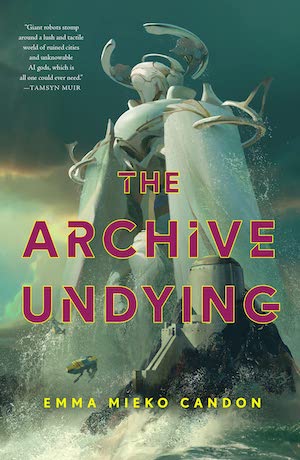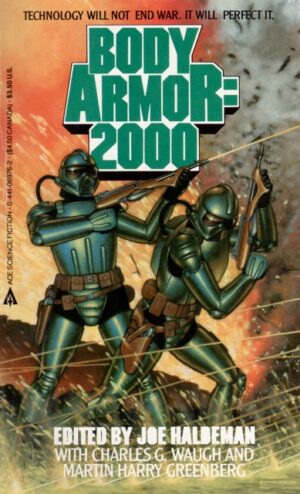In this bi-weekly series reviewing classic science fiction and fantasy books, Alan Brown looks at the front lines and frontiers of the field; books about soldiers and spacers, scientists and engineers, explorers and adventurers. Stories full of what Shakespeare used to refer to as “alarums and excursions”: battles, chases, clashes, and the stuff of excitement.
I recently ran across a paperback anthology in my basement that I had purchased when it was new in 1986. Examining it closely, I realized the spine was uncreased—it had never been read, making it a book that had been in my To Be Read pile for 37 years. The title, Body Armor: 2000, felt a bit clunky, and the cover painting awkwardly posed, but it turned out to be an excellent collection of stories, from authors ranging from the famous to the largely forgotten.
Since 1986 is the year I made an interstate move, I suspect that this anthology must have been purchased, packed away before I could read it, and then forgotten in a box in my basement. It also coincided with a busy period in my life, and also a time when I had grown weary of military adventures, and science fiction in general. And certainly, I wasn’t particularly drawn in by the title—I suspect that the year “2000” had been grafted on to make it clear what genre it belonged to (as even as late as the 1980s, the idea of the year 2000 still had the feel of a science fictional future).
When I finally got around to reading the anthology, however, I found it to be a well-constructed collection. While all the stories had something to do with the common theme of body armor, there was a lot of variety as well, with everything from gripping combat action to pathos to satire. It ended up being a strong example of what an anthology should aspire to be.
About the Editors
Joe Haldeman (born 1943) is one of the most respected science fiction authors of the 20th century. I have reviewed his classic novel The Forever War here, and you can find biographical information in that review.
Charles G. Waugh (born 1943) is an anthologist who often worked with Martin Harry Greenberg, as well as with several other collaborators, including Isaac Asimov. During his career he has published over two hundred science fiction and fantasy anthologies.
Martin Harry Greenberg (1941–2011) was an editor who produced a staggering number of anthologies during his career. I reviewed his anthology Christmas on Ganymede here, and you can find biographical information in that review.
From the copyright page, it appears most of the older stories in the anthology were drawn from Galaxy magazine, and may be available on Project Gutenberg along with other works by those authors.
Armor and Warfare
Buy the Book


The Archive Undying
The idea of armor that not only protects but augments the abilities of a soldier has long been a topic that has fascinated science fiction authors and readers. The armor from Heinlein’s Starship Troopers may stand as the single most famous example, but as Haldeman points out in the introduction of this anthology, it is far from the first, and far from the only, example. The online Encyclopedia of Science Fiction has a comprehensive article on the theme of Powered Armor, and another on the theme of Mechas, armored suits of all sizes and varieties that frequently appear in manga and anime, and have spread into all kinds of media, including movies like the 2013 film Pacific Rim.
Wikipedia also offers information on armored suits, including a section of their Weapons in Science Fiction article that addresses Powered Armor and Fighting Suits, an article on real-world Powered Exoskeletons, and a very extensive article on Mechas that is filled with links to other sources. And if you really want to go down the mecha rabbit hole, there is even a wiki called Mechapedia.
Armored suits and mechas are also popular with model builders, and I myself have more than a few, both built and unbuilt, lurking in my basement.
Body Armor: 2000
The book opens with a David Drake story, “Contact!”, set during the Vietnam War. I have reviewed a number of Drake’s books in this column, including The Forlorn Hope, Hammer’s Slammers, and The General, Book 1: The Forge. Drake (born 1945) can always be counted on for nonstop action, and this story is no exception. Like a number of other stories in the collection, while both vehicle and personal armor is mentioned in the story, it has little impact on the plot. What appears to be an alien spacecraft has the misfortune of landing amid a firefight between US and Vietnamese forces, and the American commander must choose between reporting the incident and getting his wounded evacuated. If you’ve read any of Drake’s other stories, you’ll know what the decision is.
The fictional encyclopedia entry “The Warbots,” by Larry S. Todd (born 1948), appeared in Galaxy magazine when I was about thirteen, and I remember being captivated by it. Todd is an illustrator and a cartoonist whose work primarily appeared in underground comic books and science fiction magazines, and in this liberally illustrated story, imagines what powered armor would look like from the near future right up until the year 17,500. From what was basically a walking, atomic-powered tank to swarms of amorphous drones, the warbots evolved into what were basically war gods, men who floated through space protected and propelled by force fields, surrounded by mechanical companions, with the ability to transform the resources of the enemy into weapons they controlled. I found the ideas fascinating as a teenager, and still interesting to me today.
The best story of the anthology, “The Scapegoat,” comes from C. J. Cherryh (born 1942), an award-winning author of both science fiction and fantasy, most notably the extensive Alliance-Union future history series. Humanity is tied down in a stalemate with aliens who are able to stop their own hearts when captured, making negotiations impossible. Cherryh introduces her protagonist in a scene that brings combat in an armored suit vividly to life, while stripping away any glamor from the concept. An enemy soldier surrenders, and the two engage in negotiations that could end the conflict. The solution is both alien and emotionally resonant, and this story ended up bringing tears to my eyes. Bringing a war to an end is a lot harder and less glamorous than starting them, and Cherryh thoughtfully considers the issues and sacrifices involved in such an undertaking.
George H. Smith (1922–1996) was a writer whose science fiction first appeared in Startling Stories, and whose most productive years were in the 1950s through the 1970s. His story, “The Last Crusade,” gives us warfare in armored suits with the power of a real-world main battle tank. The combatants are fighting in the ruins of a Europe destroyed by Eastern and Western factions that have forgotten their original ideology, and even why they are fighting.
The story “Hired Man” is from Richard C. Meredith (1937–1979), an American science fiction writer who also worked as an illustrator, graphic designer, and newspaper editor. It gives us a powered armor-wearing mercenary who is willing to betray his own species in pursuit of the highest paycheck, but in the end finds he has paid for his profession with his soul.
“Early Model” is not a tale of warfare. Instead, it is about an explorer who has been equipped with a cumbersome pack that provides him with an impenetrable force field whenever it is needed. The arrogant inventor, sure that the device is infallible, has also made the pack impossible to take off. And in a first encounter with an alien species on a far-off world, the explorer finds that (of course) the inventor has not considered factors painfully obvious to the man in the field. The satirical story is from Robert Sheckley (1928–2005), a science fiction author known primarily for shorter works, which often had comical themes.
Gordon R. Dickson (1923–2001), an author most widely known for his Dorsai series, gives us the story titled “In the Bone.” I reviewed his novel Tactics of Mistake here. The story follows the adventures of a man who is built into a massive warship, only to be stripped of his technology and left naked and alone by inscrutable alien explorers. Soon those same aliens end up learning that, even stripped of armor, one man can be a force to be reckoned with.
“The Chemically Pure Warriors” looks at warfare with a different type of protective suits. The story is told from the viewpoint of “axenites,” humans who feel superior because they were raised in an environment free of bacteria, viruses, and germs of any type (I did some research, and this was a topic of interest to biologists back in the 1960s when the story was written). A soldier is stripped of his protective gear in combat, and meets the indigenous people, only to find that the situation is not what it seemed to be. He ends up revolting against his leaders, who have been planning genocide against their “inferior” cousins. The author, Allen Kim Lang (born 1928) is a writer who is not widely remembered today, but produced a few dozen stories, primarily in the 1950s and 1960s.
Thomas A. Easton (born 1944) is a science fiction author most widely known for writing the book review column for Analog magazine from 1979 to 2008. His story, “Right to Life,” looks at revolutionaries rebelling against a radical pro-life faction that has developed a tight grip on politics. The presence of an armored suit on one of their targets reveals to one of the revolutionaries that the attack was expected, and is being used as a false flag to cement the power of hard-liners.
The story “Or Battle’s Sound” follows the adventures of space marines boarding an enemy vessel that contains a teleportation device that will give their opponents a beachhead on their home world. The story is tautly written and focuses on heroism and triumph, but in the end, author Harry Harrison leaves the reader with an unsettling warning about the dangers of reveling in war. Harrison (1925–2012) was a prolific and influential science fiction author, and known for his anti-war sentiments. He is most widely remembered for his humorous stories of the Stainless Steel Rat, and I have reviewed his work here, here and here.
“Hero,” from the collection editor Joe Haldeman, is the first section of his novel The Forever War, and I believe it appeared in this form in Analog prior to the publication of the full novel. It follows trainees preparing for armored combat with an alien race that has clashed with humanity. The story is a classic, and required reading for anyone who enjoys military science fiction.
Final Thoughts
Body Armor: 2000 is a good example of a themed anthology—a collection of some excellent stories that look at warfare from a wide variety of viewpoints. It also contained a good mix of old and new stories, classics from familiar authors alongside works from lesser-known writers. If you’d like to discuss any of those stories or authors, I’d be glad to hear from you. I’d also be interested in hearing about your favorite stories of armor-clad warriors and mechanical battle suits, be they from books, comic books, or movies.
Alan Brown has been a science fiction fan for over five decades, especially fiction that deals with science, military matters, exploration and adventure.










